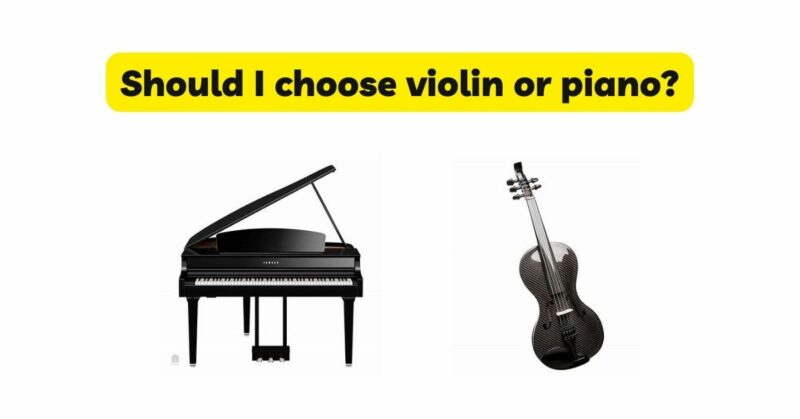Choosing between the violin and piano can be a challenging decision for aspiring musicians. Both instruments offer unique musical experiences and opportunities for artistic expression. In this article, we will explore the considerations involved in deciding between the violin and piano, including factors such as personal preferences, musical goals, technical demands, expressive capabilities, learning approaches, and practical considerations. By examining these elements, we aim to provide guidance to individuals seeking to make an informed decision that aligns with their musical aspirations and interests.
- Personal Preferences and Musical Affinity: One of the first considerations when choosing between the violin and piano is personal preference. Reflect on the sounds that resonate with you the most and the genres of music that captivate your interest. The violin’s expressive and lyrical qualities are often associated with classical and romantic music, as well as folk and world music genres. Its ability to imitate the human voice and convey a wide range of emotions may appeal to those seeking a more intimate and lyrical musical experience. In contrast, the piano’s versatility allows for exploration across various musical styles, from classical to jazz, pop, and contemporary genres. Consider your musical inclinations and the instrument that aligns most closely with your artistic sensibilities.
- Musical Goals and Aspirations: Your musical goals and aspirations should play a significant role in your decision-making process. Are you looking to pursue a professional career in music, perform in ensembles or orchestras, or collaborate with other musicians? Or do you aim to develop a fulfilling hobby, play for personal enjoyment, or entertain friends and family? Consider the musical path you envision for yourself and how each instrument can support your aspirations. While both the violin and piano offer diverse musical opportunities, clarifying your goals will help align your decision with the instrument that best suits your desired musical journey.
- Technical Demands and Learning Curve: Understanding the technical demands and learning curve of each instrument is crucial when making a decision. The violin requires precise finger placement, bow control, and a keen sense of intonation. Techniques such as shifting, vibrato, and bow articulation demand dedicated practice and a solid foundation in violin technique. The absence of visual cues, such as keys or frets, requires a heightened level of sensory and kinesthetic awareness. On the other hand, the piano demands finger independence, hand coordination, and the ability to navigate complex musical arrangements. Developing finger dexterity, understanding music theory, and mastering techniques such as scales, chords, and dynamic control are integral to piano proficiency. Consider the technical challenges and learning approaches of each instrument and assess which aligns more closely with your strengths and interests.
- Expressive Capabilities and Artistic Expression: Consider the expressive capabilities of each instrument and how they align with your desire for artistic expression. The violin’s ability to mimic the human voice and convey a wide range of emotions through its expressive qualities appeals to those who seek to communicate their innermost feelings through music. Techniques such as vibrato, bow articulation, and dynamics enable violinists to deliver nuanced musical phrasing and captivating performances. The piano, with its broad dynamic range and versatility, allows for exploring a diverse spectrum of tonal colors and textures. Pianists can employ techniques such as touch, pedal control, and hand positioning to convey their artistic interpretations. Reflect on which instrument resonates with your desire to express yourself most authentically and aligns with the kind of musical statements you wish to make.
- Practical Considerations: Practical considerations, such as instrument availability, access to lessons, and space requirements, should also be taken into account. The violin is a portable instrument, making it easier to transport and practice in various locations. However, finding a suitable teacher and securing a quality instrument may require some research and investment. The piano, on the other hand, is a larger instrument that requires dedicated space and maintenance. Access to a piano for practice and lessons may be more readily available, but it is important to consider the financial and logistical aspects associated with owning or accessing a piano. Evaluate your circumstances and determine the practical feasibility of pursuing either instrument.
- Exploratory Opportunities and Musical Versatility: Consider the exploratory opportunities and musical versatility that each instrument offers. The violin’s distinctive sound and expressive capabilities make it an ideal instrument for chamber music, solo performances, and orchestral settings. It is also well-suited for exploring different musical traditions and genres. The piano, with its broad range and polyphonic capabilities, allows for solo performances, collaborative ensemble playing, and a wide range of repertoire options. It serves as a foundational instrument for composers, arrangers, and those interested in exploring harmony and composition. Reflect on the types of musical experiences and opportunities you desire and assess how each instrument aligns with your versatility and exploratory aspirations.
Conclusion: Choosing between the violin and piano is a deeply personal decision that should be guided by personal preferences, musical goals, technical demands, expressive capabilities, learning approaches, and practical considerations. Consider your affinity for each instrument’s sound, the genres of music that resonate with you, and the expressive qualities you wish to explore. Align your decision with your musical goals, whether they involve pursuing a professional career, developing a fulfilling hobby, or engaging in collaborative music-making. Evaluate the technical demands and learning approaches of each instrument, and assess which aligns more closely with your strengths and interests. Consider the practical feasibility of owning or accessing the instrument, as well as the availability of lessons and practice opportunities. Ultimately, the instrument you choose should resonate with your artistic sensibilities, ignite your passion, and bring you joy and fulfillment on your musical journey.


